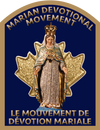Preliminary Remarks, Chapter One
Echo of God Footnotes. Preliminary Remarks. Chapter One
Notes 3.& 4. Pope Paul VI Marialis Cultus. (Vatican City: Italy) February 2, 1974 #25 & #26
“Pope Paul VI came out with this beautiful Encyclical called Marialis Cultus; really recommend that you read it" -Dennis Girard ;)
Marialis Cultus is an Apostolic Exhortation by Pope Paul VI issued on February 2, 1974. It is subtitled “For the Right Ordering and Development of Devotion to the Blessed Virgin Mary,” and outlines the various ways in which Mary is honoured in the Roman Catholic Church. It was written to inform priests and Bishops of the proper celebration of Marian devotions observed by the Church, and to help guide the faithful in the proper celebration of these devotions, especially within the liturgy, according to Church doctrine and in line with reforms from Vatican II.
The letter is divided into three parts: the first outlines the role of Our Lady in the Sacred Liturgy and reflects on her example as “the Model of the Church in Divine Worship," the second provides recommendations for development of future Marian devotions, and the third is focused on the Angelus prayer and the Rosary.
The first part of the exhortation gives an overview of the Solemnities and various feasts of the Blessed Virgin as they are ordered in the liturgical calendar. It describes the ways in which Our Lady is venerated in the celebration of Holy Mass, in both the readings of Sacred Scripture and the liturgical prayers. As well, Pope Paul VI reflects on the relationship between Mary and the Church. He states that as a result of her outstanding virtues (including perfect faith, charity, and unity with Jesus), “Mary is not only an example for the whole Church in the exercise of divine worship but is also, clearly, a teacher of the spiritual life for individual Christians.” Mary’s role as our teacher is especially true for those who strive to live the lifestyle of True Devotion to Mary, as outlined by St. Louis de Montfort.
The second part provides guidelines for devotion to Our Lady. It stresses the essential Christocentric nature of Marian Devotion; Mary must always be understood in relation to Jesus Christ. “In the Virgin Mary everything is relative to Christ and dependent upon Him.” In celebrating Our Blessed Mother’s role in salvation history, we can come to better know, and to increase our worship of, Jesus Christ Himself. Our Lady's foremost desire is to bring us closer to her beloved Son.
The three aspects of devotion to Our Lady which are generally observed by the faithful are:
• veneration, showing her great honour and respect
• Imitation of her virtues
• Invoking her intercession as Mother of the Church and Queen of Heaven and Earth
The letter emphasizes that all elements of the churches' life of prayer, including Marian devotions, should be inspired by the Bible and be in harmony with the liturgy.
The third part of the letter discusses two time-honoured devotions to Our Lady: the Angelus and the Rosary
The letter encourages the faithful to continue with the traditional recitation of the Angelus. Through this age old prayer, we sanctify different parts of the day, contemplate the incarnation of the Word made flesh, and call upon divine intercession. The writer concludes that despite the passing of the centuries the Angelus retains unaltered value.
The exhortation then encourages renewal of “the pious practice” of the Holy Rosary of the Blessed Virgin Mary. Considered to be a treasury of the entire Gospel, the rosary is a prayer of both praise and petition.
The rosary consists of various elements combined in harmony:
· Contemplation with Mary on the succession of key events of our salvation in Jesus Christ
· The Our Father, which is of immense value as it was given to us by Our Lord Himself
· Litany-like succession of the Hail Marys; prayer of praise and petition to Our Blessed Mother while honoring the “fruit of thy womb, Jesus"
· The Glory Be; praising the three persons of the Holy Trinity
It important to take the time to pray the rosary with a lingering pace, quietly pondering the mysteries of Our Lord's life through the eyes of the person who knew Him best; His Blessed Mother. The letter also stresses the importance of praying the Rosary in the family, the “domestic church.”
The letter concludes that Church's devotion to our Blessed Mother is “an intrinsic element of Christian worship.” Devotions to the Blessed Virgin Mary are of much value, both theologically and in encouraging renewal of the Christian way of life. Such devotion is firmly based on Sacred Scripture, and recognizes the key role of Our Lady in God’s plan of our salvation through Jesus Christ, as well as her continuing mission to bring all her children into virtuous living and to eternal life with her firstborn Son. She loves us with a Mother’s love, providing unceasing assistance and protection, and leads her children to fight sin and evil with energy and determination. As Pope Paul VI writes, “the Virgin's maternal intercession, her exemplary holiness and the divine grace which is in her become for the human race a reason for divine hope.”
The Apostolic Exhortation Marialis Cultus is an excellent resource for all who are learning to live the lifestyle of True Devotion to Mary. This beautiful expression of Pope Paul VI’s love for our Blessed Mother serves as an essential guide to understanding and expressing the wide array of devotions to Mary that are celebrated in the Catholic Church.
References
Pope Paul VI Marialis Cultus. (Vatican City: Italy) February 2, 1974.

